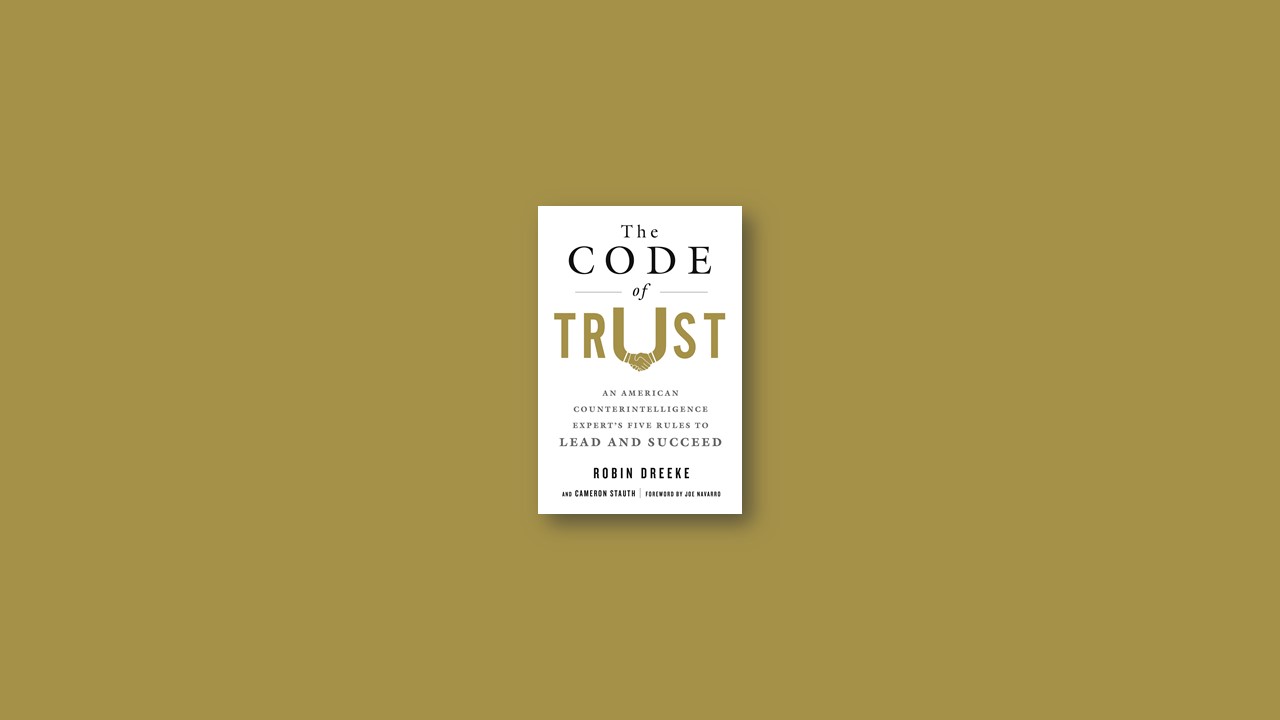The Five Rules to Gain Trust
#1 Suspend your ego
Each of us, by the very nature of our existence, is and must remain the focus of our own life. To gain the gift of another’s trust, you must grant them that natural, normal focus. Their life, regardless of all the people they’re responsible for, is all about them. Not you. If you accept that, they will open the door of their trust to you. The single most compelling trait of trust is simple humility.
#2 Be nonjudgmental
Respect the opinions, attitudes, ideas, and perspectives of all people—no matter how foreign, or even opposed to your own. No one trusts people who look down on them, and no one trusts people who don’t understand them. Not being judgmental is the greatest invitation to trust that you can possibly offer.
#3 Validate others
There is common decency in every person—regardless of their opinions—and to be worthy of their trust, you must recognize their common decency, show them your own, and join them in that shared respect. All of us are born with the sacred right to our own ideas, and not one of us was born with the desire to destroy or alienate others. Common decency is the common ground of humankind.
#4 Honor reason
Resist every temptation to personalize, emotionalize, debate, exaggerate, manipulate, or coerce. Stick to the facts, and be honest. Only those who rely on reason, reflected by honesty, can create the foundation of rational, shared self-interest that all enduring trust rests upon. Trust inspired by mere emotionalism lasts only as long as the next emotion. Leadership inspired by fear is simply fear. Give people a good reason to trust you, and they will.
#4 Be generous
Don’t expect to receive the gift of trust unless you offer a gift of your own. People do not allow themselves to trust those who create one-sided relationships. Selfishness repels. Generosity attracts. The most generous gift you can offer is your own trust. The most lasting gift you can offer is the loyalty of enduring trust.
The Four Steps To Inspire Trust
#1 Align Your Goals
First: Determine your own ultimate goal: the prize that justifies your sacrifices. Choose it carefully, and follow it faithfully. Don’t get distracted by lesser goals, no matter how pivotal they may appear at the time. Second: Learn the goals of others, and find valid, honest reasons to respect those goals. Third: Seek ways to align your goals with theirs. As you begin this process, look for ways to make their goals part of your goal, and your goal part of theirs. If you’re successful, you’ll achieve the power that only combined forces can attain.
#2 Apply the Power of Context
To successfully align yourself with others, you need to discover their desires, beliefs, personality traits, behaviors, and demographic characteristics: the central features that define their context. When you know where they’re coming from, you’ll be able to know them inside and out. You’ll know who they are behind the personality that they’re trying to project—or, possibly, the person that you fear they may be. Knowing others includes knowing how they see you. If they get the wrong impression, show them the real you. Because people are who they are, approach them on that level, without trying to make them into something they’re not. In short: never argue context.
#3 Craft Your Encounters
When you meet with potential allies, plan the meeting meticulously: especially the first one. Create the perfect environment for it. Know—before the meeting begins—its proper mood, the special nature of the occasion, the perfect time and place, your opening remark, your goal, and your gift: what you have to offer. With well-crafted encounters, you’ll be able to travel toward trust with the force of a river to the sea, carrying everyone present on the same current.
#4 Connect
To successfully align your goals—and maintain the alignment—speak the same language: figuratively, and literally. Words—and the character traits they reveal—are the primary tools that build trust. To create strong, lasting relationships that fulfill goals, speak the language of reason, respect, and consideration. The language of trust—verbal and nonverbal—does not express egotism, judgment, irrationality, or selfishness. It is a language—and a lifestyle—of understanding, validation, and help. It’s about them, not you. Even when relationships change, and goals are forgotten, words and the sentiments they convey can remain in the brain forever
The Nine Drills to Build Your Trust Muscles
Drill #1: Establish a time constraint
Just knowing someone doesn’t mean they deserve less than your best. Their time is just as valuable as that of a stranger.
One of the best is simply to ask, “How are you doing for time?” That makes it so much easier for them to disengage. Of course, you may not want them to disengage, but it’s not about you. You can also use a nonverbal: check your watch, put on your hat, rise out of your seat, or remain standing, instead of sitting down.
The goal is to engage them in conversation for at least a few moments, and the ultimate goal is to make them feel so comfortable that they extend the conversation themselves.
Drill #2: Use the third-party reference technique.
Your goal is to connect with a total stranger, by talking about something immediately at hand. Find a person who is engaged with some thing or activity, which serves as the “third party” that you will refer to. The third party can be a book in a bookstore, carrots at a supermarket, or a sports team on TV
Approach the subject and make a reference to the neutral issue at hand: the book, the carrots, or the team. Empower them by seeking their thoughts and opinions on the neutral issue: “Do you know if these are GMO carrots?” Or, “My wife just read that book, and I want to buy.”
Drill #3: Speak at the speed of trust.
Although innumerable trustworthy people speak quickly, there’s a good reason that people who aren’t trusted are colloquially referred to as fast-talkers: some people purposefully accelerate their speech when they want to hide something or confuse you because it gives you less time to think about what they’re saying. It’s the verbal equivalent of fine print. Consider, for example
Pick a topic that fits your listener and warrants an extension of the conversation. Speak about it notably more slowly than usual, but focus on sounding thoughtful and meaningful—as if you’re trying to communicate emphasis. Don’t just slow down mechanically or arbitrarily because you might sound creepy.
To gauge your success, keep track of eye contact. If they’re losing interest, it will show.
For contrast, do the same thing while talking faster than usual. You can even do it in the same conversation.
You’re almost certain to see notable results.
Drill #4: Employ the assistance technique.
People are hard wired to enjoy offering assistance—as not only a mechanism to receive assistance themselves, but also to satisfy the innate human drive for altruism.
Connect with a stranger—or someone you know—by asking for assistance. This bonding exercise often feels more profound when you do it with a stranger, but it’s of more practical value when you do it with someone you already know, because you’re more likely to see them again.
When you ask for help, keep it short, and get to the point. Your opening line can be as simple as: “Excuse me, if you have a second, do you know if there’s WiFi in this building, and if there is, do you need a password?”
Drill #5: Empower others
Approach someone—a stranger or a person you already know—and have a conversation that’s solely about their needs, wants, challenges, and opinions.
Keep your own ideas to yourself, no matter how tempted you are to offer them.
If you have good stories that relate directly to the issue at hand, forget about them.
Pay such careful attention to them that they begin to offer you equal attention.
Do absolutely nothing that indicates that you have a relatively higher rank in the status hierarchy than they do—because in the context of a trust-based relationship, whatever title or position you have is irrelevant to them. All they care about is being treated with nonjudgmental validation, understanding, rationality, and generosity. The goal: make them feel so comfortable that they speak with animation and pleasure, and seem somewhat reluctant to end the conversation.
Drill #6: Don’t agree to disagree
Bring up a controversial topic, particularly one that you think your subject feels differently about than you do—and don’t disagree with them, no matter what they say.
Express genuine curiosity about why they feel the way they do, and tell them you appreciate seeing their interesting perspective. Encourage them to elaborate. Do not correct them if they say something that you think, or even know, is false.
Don’t try to change their mind, or to “enlighten” them in any way. Allow them full freedom of thought.
Attempt to see the topic so clearly from their perspective that you actually begin to tweak certain elements of your own opinions.
The goal: make them feel so safe in your presence that they share their opinions with total candor.
Drill #7: Tap the power of apology.
Great leaders apologize more often than most people. It’s not because they’re wrong more often. It’s because they’re humble enough to offer apologies without feeling personally demeaned, and know that nothing signifies concern and respect for others better than an apology
Apologize to somebody today. Don’t worry about finding the opportunity. If you’re a leader, it will find you. You may need to ask for sacrifice, which is the very essence of teamwork, or some plan may fail that you played a part in.
There are many ways to craft an apology, so find one that suits your personality. The only inviolable rule: If your apology includes the word but, you’re the butt.
Drill #8: Remove the poison from a toxic person
Don’t take the attack personally and get emotionally hijacked. That’s usually what a toxic person wants, because conflict is often a form of sport to them. For the most part, they’ve abandoned hope that reason, empathy, and generosity will serve their needs, and have retreated into their own dark world of head games and war games.
Instead of giving them what they want, give them what they need: validation, understanding, generosity, rationality, and inclusion.
Those universally desired qualities can fill the deep holes of hurt in almost anyone. Don’t expect it to work immediately. But expect it to work.
Drill #9: Reprimand without rancor
Identify a challenge that someone is having, and instead of being notably critical, help them solve it, to your mutual satisfaction, without even letting them know that they are being reprimanded.
That can be easier than it sounds, since many people don’t even realize they’ve made a mistake—partly because they didn’t intend to be a screw-up, and did what they thought was right. In that situation, the mistake was simply part of their context, and there’s no point in arguing about it.
If your goal is to have them recognize your context, and do things the way you want them done, ask yourself: Why should they? The correct answer is not: “Because I’m the boss”—or, “Because I know best.”
The reason is because your way is the right way. It’s not because the right way is your way.


